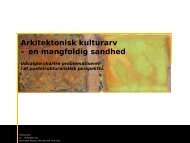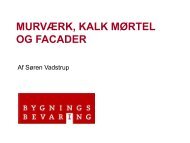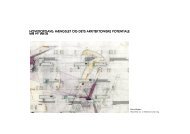TransformaTion TRANSFORMATION - Rum
TransformaTion TRANSFORMATION - Rum
TransformaTion TRANSFORMATION - Rum
You also want an ePaper? Increase the reach of your titles
YUMPU automatically turns print PDFs into web optimized ePapers that Google loves.
Betydningen af ordet<br />
restaurering har løbende<br />
ændret sig. Det er belyst<br />
og dokumenteret gennem<br />
over 150 års teori<br />
og praksis. Restaurering<br />
betegner en handling, et<br />
indgreb, man påfører et<br />
objekt. Indgrebene kan<br />
have forskellig hensigt<br />
og karakter, hvilket er<br />
søgt illustreret med<br />
denne skematiske<br />
opstilling. Sat her<br />
overfor er en transformation<br />
at betragte som<br />
en hændelse, der mere<br />
eller mindre uomgængeligt<br />
altid vil overgå<br />
et objekt – også via en<br />
restaurering.<br />
The meaning of the<br />
word restoration has<br />
undergone a gradual<br />
change. it has been<br />
illustrated and documented<br />
by more than<br />
150 years of theory and<br />
practice. restoration<br />
signifies an action, an<br />
intervention in the state<br />
of an object. These<br />
interventions vary in<br />
intention and character,<br />
a fact which may be<br />
illustrated by this<br />
diagram. A transformation,<br />
on the other hand,<br />
signifies an event which<br />
will happen to an object<br />
more or less as a matter<br />
of course.<br />
The word “transformation” has become an<br />
architectural term in Denmark and is<br />
associated with architectural heritage on<br />
every level. To those who have traditionally<br />
worked within this field, the term restoration<br />
has been the most common. Some welcome the<br />
term transformation, while others wonder<br />
about the actual meaning of this word. What<br />
does the word denote? This article addresses<br />
that question.<br />
This is not a scientific article offering a careful<br />
and exhaustive study and explanation of the<br />
history, use and development of the terms but<br />
rather an expression of the author’s view of and<br />
experience with the use of words in the field of<br />
architectural heritage. Thus, my hope is to<br />
stimulate the discussion about the use of<br />
professional terminology in the hope that in the<br />
long term, the discussion in itself will facilitate a<br />
common understanding within the field of<br />
architecture. This will enable a more precise<br />
exchange, and perhaps we can better avoid<br />
clichés, superficial jargon and misunderstandings,<br />
which often serve to divide architects into<br />
more or less necessary polarisations.<br />
The word transformation is often presented as<br />
either a contrasting or a parallel term to the<br />
word restoration. But what is the origin of the<br />
word? This article attempts to help clarify where<br />
in the architectural profession the word appears.<br />
In the late 1990s, a Department for Transformation<br />
was established at the Aarhus School of<br />
Forny<br />
renew<br />
Rekonstruere<br />
reconstruct<br />
Udskifte<br />
replace<br />
Renovere<br />
renovate<br />
Tilføje<br />
Add<br />
Architecture as a parallel to Afdeling for<br />
Restaurering, By- og Bygningspleje (department<br />
for restoration and city and building<br />
care); the more cumbersome name and its<br />
meaning were the result of careful consideration<br />
by then Professor Johannes Exner and<br />
current Professor Gert Bech-Nielsen. The word<br />
transformation, however, appealed to certain<br />
students who only wanted to work creatively on<br />
the design of historical buildings, and who did<br />
not care to “waste their time” on methodical<br />
building studies and the like.<br />
The words, their usage and the meaning we<br />
ascribe to them have a history. The word<br />
restoration has more than 150 years of history,<br />
and its meaning has included anything from<br />
Viollet-le-Duc’s reconstructions to Fehn’s and<br />
Scarpa’s work with staging historical monuments.<br />
There is still some disagreement about<br />
the proper meaning of restoration, and the<br />
question is whether we can ever reach an<br />
agreement, as the concept is constantly<br />
evolving.<br />
The word transformation has challenged the<br />
word restoration and gained popularity.<br />
Architects use a wide range of words to<br />
characterise what they do. They like to use new<br />
words to demonstrate that they have “invented”<br />
something new. But the more overarching and<br />
generalised the words are, the vaguer their<br />
meaning appears. The word transformation is<br />
vague, and indeed, many consider it a buzzword.<br />
Reparere<br />
repair Forstærke<br />
intensify<br />
TRanSFORmeReT OBjeKT<br />
TrANsformed objecT<br />
Borttage<br />
remove<br />
thought model<br />
Omplacere<br />
relocate<br />
Genbruge<br />
reuse<br />
Beholde<br />
retain<br />
Konservere<br />
Preserve<br />
The entry for the word transformation in<br />
Den Store Danske Encyklopædi (The Great<br />
Danish Encyclopaedia) includes the following<br />
introduction 1 :<br />
“transformation (from Latin transformatio,<br />
‘change, conversion’, from trans- and formare,<br />
‘form’), in the theory of evolution the changes<br />
in hereditary material that lead to the emergence<br />
of new races and species. A transformation<br />
series is a presentation that describes the<br />
evolution of a species from a primeval form<br />
through one or more intermediate forms. See<br />
also evolution.”<br />
It has been clear ever since the word transformation<br />
first entered the professional terminology<br />
in the schools of architecture that the use of<br />
the word had a highly normative and attitudinal<br />
slant. Not least among the students, who often<br />
find it important to profile themselves or the<br />
group they belong to in relation to others. It is<br />
essential to be progressive and “with it” rather<br />
than being pigeonholed and, in the worst case,<br />
marginalised as someone who lags behind the<br />
times, blind to anything but the good aspects of<br />
the past. Students are sensitive to fashions, as<br />
are architects in general when it comes to being<br />
characterised as “hot or not”. This appears to be<br />
a burdensome fact of the trade, and one must<br />
behave accordingly. However, it often makes it<br />
harder to reach the true, professional core of an<br />
issue, as the quick form project always beats the<br />
more protracted and explorative project with<br />
regard to branding.<br />
arkitektur dk 3 2011 5



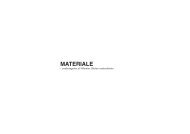
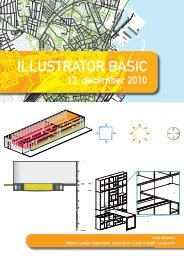

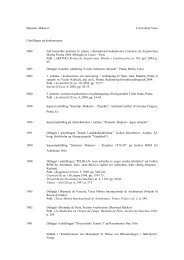
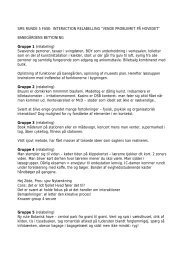
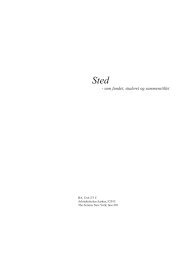

![KONKURRENCE [KÅRK] - Rum - Arkitektskolen Aarhus](https://img.yumpu.com/18524393/1/184x260/konkurrence-kark-rum-arkitektskolen-aarhus.jpg?quality=85)


